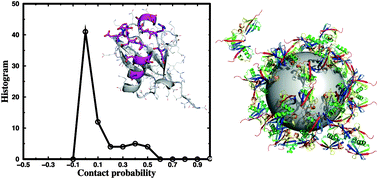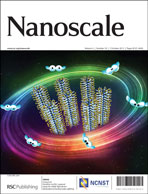Direct observation of a single nanoparticle–ubiquitin corona formation†
Abstract
The advancement of nanomedicine and the increasing applications of nanoparticles in consumer products have led to administered biological exposure and unintentional environmental accumulation of nanoparticles, causing concerns over the biocompatibility and sustainability of nanotechnology. Upon entering physiological environments, nanoparticles readily assume the form of a nanoparticle–protein corona that dictates their biological identity. Consequently, understanding the structure and dynamics of a nanoparticle–protein corona is essential for predicting the fate, transport, and toxicity of nanomaterials in living systems and for enabling the vast applications of nanomedicine. Here we combined multiscale molecular dynamics simulations and complementary experiments to characterize the silver nanoparticle–ubiquitin corona formation. Notably, ubiquitins competed with citrates for the nanoparticle surface, governed by specific electrostatic interactions. Under a high protein/nanoparticle stoichiometry, ubiquitins formed a multi-layer corona on the particle surface. The binding exhibited an unusual stretched-exponential behavior, suggesting a rich binding kinetics. Furthermore, the binding destabilized the α-helices while increasing the β-sheet content of the proteins. This study revealed the atomic and molecular details of the structural and dynamic characteristics of nanoparticle–protein corona formation.


 Please wait while we load your content...
Please wait while we load your content...